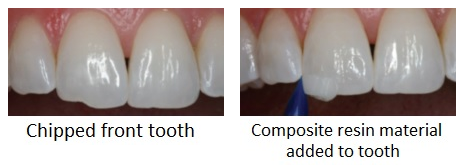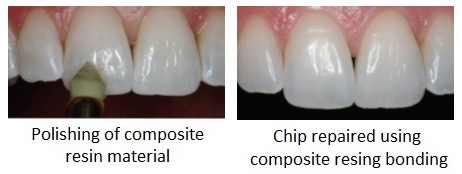Direct Composite Bonding for Damaged Teeth
Written by Ross Nash, DDS Last modified on August 24, 2018
One of the simplest and most common restorative dental procedures is direct composite bonding. It offers an effective solution to a host of dental concerns, ranging from repairing chips and cracks in teeth, to lengthening or altering their shape for esthetic purposes.
Given the popularity of direct composite bonding, I thought I’d take some time to respond to a few of the more frequently asked questions from patients who visit Consumer Guide to Dentistry.

Q. What is Direct Composite Bonding?
A. Direct composite bonding is the process of adhesively attaching a tooth-colored material to natural tooth structure. To perform this relatively simple procedure, the tooth is shaped (if needed) and treated with a bonding agent. Once the tooth is prepped, a composite resin material made of glass and plastic is placed and contoured on the tooth surface, where it is then hardened with a high-intensity blue light. Finally, the bonded composite is shaped and polished.
Q. What Problems can Composite Bonding Correct?
A. Restoratively, teeth that have been worn, chipped, broken or decayed can be restored with composite bonding. Cavities in front or back teeth can also be filled using bonded composite resin materials. Cosmetically, teeth that are dark in color or have natural defects can be completely veneered to create a new surface using composite bonding.
Q. Are the Materials Strong Enough to Replace Parts of a Natural Tooth?
A. Yes. Modern composite resin materials are very strong and durable, and can be used in many situations.
Q. How Long can I Expect Composite Restorations to Last?
A. In the proper clinical applications, you can expect a well-placed composite resin restoration to last for five-to-ten years.
Q. Can any Dentist Provide These Types of Tooth-colored Restorations?
A. Most dentists are trained in adhesive composite resin bonding. However, the final result is in the hands of the clinician providing the treatment. Some have more artistic ability than others and the esthetic results often differ from dentist to dentist.
Q. Are Composite Restorations Expensive?
A. Direct restorations can usually be placed at a cost that is affordable for most people. (Check out Consumer Guide to Dentistry’s comprehensive article for more information about the cost of bonding.)



